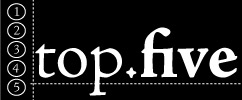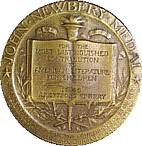
Last summer I completed my quest of reading all 69 Caldecott Medal winners. Since then, one of my favorite children’s book authors and illustrators, David Wiesner, won the 2007 Caldecott Medal for Flotsam.
The Caldecott Medal is primarily recognition for outstanding art and illustrations, though how these illustrations work with the text of the book is a factor in its excellence. In my own list of favorites, text plays heavily into how much I like the book – almost equal in importance. Thus my list is more of a list of my picks for all around brilliance and personal all time favorites out of the 70 Medal winners.
1. Where the Wild Things Are written and illustrated by Maurice Sendak. (1964 Medal)
This is one of the most beloved children’s books of all time, and holds top spot in my heart as well. Every word, picture, and detail is imaginative and perfect.
2. Many Moons written by James Thurber and illustrated by Louis Slobodkin. (1944 Medal)
James Thurber is just as brilliant and funny while telling a children’s story. Slobodkin’s pen and color illustrations are squiggly and charming. I have no idea why someone felt the need to release a later version with different illustrations. Why redo a Caldecott winner? This is the story of a Princess named Lenore who is sick and wants the moon to make her feel well again. The story is hilarious, and the moral is wise: perspective is everything.
3. May I Bring a Friend? written by Beatrice Schenk de Regniers and illustrated by Beni Montresor. (1965 Medal)
This is a cute story of a king and queen who are friends with a small boy and invite him to meals. The boy always asks if he can bring a friend. The answer is always yes, even though he keeps bringing zoo animals as his guests! The illustrations are grand and expressive – they do a great job showing how over the top and funny it is to have animals at the dinner table.
4. Fables written and illustrated by Arnold Lobel. (1981 Medal)
I love Arnold Lobel (the imagination behind Frog and Toad), and this book is my favorite of his. Each spread is a different fable, one side for the story, and one side for the accompanying illustration. The fables are funny and creative, and they each have a fitting moral at the end. The illustrations are of the same beautiful style as the Frog and Toad books.
5. Song and Dance Man written by Karen Ackerman and illustrated by Stephen Gammell. (1989 Medal)
This is a beautifully sweet story of a grandfather revisiting his youthful days to people who appreciate it as if it were new: his grandchildren. Grandpa was a vaudeville song and dance man, and revives his music and jokes to entertain his loving audience of three. The illustrations are gorgeous and creative, with lots of bright colors.
1. Sector 7 written and illustrated by David Wiesner (2000 Honor)
2. Zen Shorts written and illustrated by Jon J. Muth (2006 Honor)
3. What Do You Say, Dear? written by Sesyle Joslin and illustrated by Maurice Sendak (1959 Honor)
4. Peppe the Lamplighter written by Elisa Barton and illustrated by Ted Lewin (1994 Honor)
5. Lion written and illustrated by William Pene de Bois (1957 Honor)
